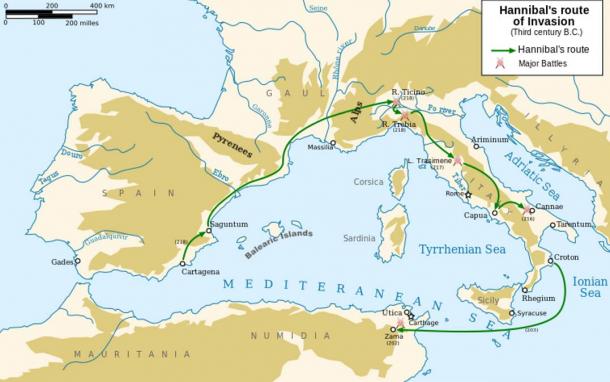【翻譯】在西班牙發現2200年前的護城河與漢尼拔相關文物
原文譯自http://www.ancient-origins.net/news-history-archaeology/2200-year-old-moat-artifacts-linked-hannibal-unearthed-spain-002637
其實這也不算大新聞,西班牙算是對漢尼拔戰爭的一系列古蹟很用心的,各地經常挖出一堆古物,例如前幾年Santo tome就有發現部分會戰遺跡,但因為西班牙的經濟問題,說好要蓋博物館,等到現在也沒影,總之是挖出來如果不是震驚世界的話通常是沒啥下文啦~此處的關於漢尼拔講的不多也不是很細,本來想要逐段補充,但後來翻完一遍就覺得媽呀這簡略到可能補充還比正文長,所以就把相關書籍補充在最後,有興趣的人再自己去探索囉~
2,200-year-old moat with artifacts linked to Hannibal unearthed in Spain
在西班牙發現2200年前的護城河與漢尼拔相關文物。
Spanish university students trying to retrace Hannibal’s war march through northeastern Spain have found a huge buried moat with ancient objects in it. The moat may have been meant to protect the ancient Carthaginian warrior-leader’s troops who remained in Iberia. If the moat was defense works for Hannibal’s Iberian troops, it did little good: Romans defeated them after Hannibal departed in 218 B.C.
Hannibal left to attack the Roman Empire in Italy with as many as 90,000 infantry and 12,000 cavalry. He had with his army a famous elephant brigade of 80 or so pachyderms, most of which, scholars think, perished in the harsh mountain terrain between Spain and central Italy.西班牙大學生試著追溯漢尼拔穿越北西班牙的行軍路線,並找到一個被埋藏的巨大護城河與古老的文物。護城可能是保護駐紮在伊比利亞半島的古迦太基軍隊,若此護城河是為了漢尼拔軍團做的防禦工程,那可能效用不高,在漢尼拔西元前218年離開後,羅馬軍就打敗他們了。
漢尼拔帶領9萬步兵、一萬兩千騎兵,以及他那被大部分學者認為喪生於嚴酷山地的著名象隊,前去攻擊義大利的羅馬帝國(註)。
- 此處應為誤植,當時羅馬仍是共和國。
【翻譯】一窺羅馬萬神殿
原文譯自http://www.monolithic.org/stories/the-pantheon-rome-126-ad
討論關於萬神殿的特色與建築方式。譯註:我個人認為這篇不算是太嚴謹的文章,有小歷史錯誤、專有名詞錯誤和誤植,二是他很多內容是把別人網站複製貼上,但其來源在第一手文獻資料可能沒有,或是是別的呈現形式,但整體來說對萬神殿的描述無啥偏頗。
該篇工程名詞頗多,一個簡單的英文單字到工程學中完全變了樣,查了不少資料才勉強知道是甚麼施工技法,翻完這篇後確實有助於羅馬建築技術的理解就是了。
最後,本人英文極差,若有譯錯之處還請狠狠地指正。
The Pantheon – Rome – 126 AD
Freda ParkerA temple to all gods
獻給諸神的殿堂Michelangelo (1475-1564) looked at everything with an artist’s critical eye, and he was not easily impressed. But when Michelangelo first saw the Pantheon in the early 1500s, he proclaimed it of “angelic and not human design.” Surprisingly, at that point, this classic Roman temple, converted into a Christian church, was already more than 1350 years old.
What’s even more surprising is that the Pantheon, in the splendor Michelangelo admired, still stands today – another 500 years after he saw it.
米開朗基羅(1475-1564)總是用藝術家批評的眼光審視一切,且不輕易感動,但米開朗基羅在 1500年早期見到萬神殿時,他宣稱這是:「天使所成,而非人為的設計」,而在此時,這座古羅馬神廟已經被轉成基督教堂超過1350年了。
更驚人的是,萬神殿那令米開朗基羅驚嘆的光彩,在他500年後依然可見。
【翻譯】笑看古羅馬
原文來自http://www.newstatesman.com/culture/2014/06/mary-beard-humour-ancient-rome-was-matter-life-and-deat
是篇討論羅馬人幽默感的文章,節錄很多很好笑的羅馬搞笑言談,也討論了一些政治上的「笑」點,是篇值得一看的好文。本文作者為Mary Beard,是頗富盛名的學者,出過諸多關於古典時期的書籍,在台灣有出版的中譯本為《羅馬大競技場的故事》,她的部落格有許多有趣的文章:http://timesonline.typepad.com/dons_life/
此文是她所出版的《Laughter in Ancient Rome ― On Joking, Tickling, and Cracking Up》一書的節選。譯註:標準的全部的字都看的懂,但湊在一起不知道怎麼回事的文章,所以可能會翻譯很多錯,還請大家幫忙指正<(_ _)>
文中使用非常多英國時事梗,查梗查到吐血,關於羅馬的部分有些史料在書上看過,也是一樣能盡量幫大家補充就盡量補充。Mary Beard: humour in ancient Rome was a matter of life and death
幽默在古羅馬是生死攸關的大事It has always been bad for your public image to laugh in the wrong way or to crack jokes about the wrong targets, not least in the presence of Caligula…
用錯誤的方式大笑,或開錯玩笑可能會危害你的公眾形象,尤其是在卡利古拉的時代……One evening at a palace dinner party, in about 40AD, a couple of nervous aristocrats asked the emperor Caligula why he was laughing so heartily. “Just at the thought that I’d only have to click my fingers and I could have both your heads off!” It was, actually, a favourite gag of the emperor (he had been known to come out with it when fondling the lovely white neck of his mistress). But it didn’t go down well.
西元40年,在某個皇宮的晚宴中,一對貴族夫妻緊張地問皇帝卡利古拉:為何他笑的如此開懷?
「只要彈個手指,我就能擁有兩位的頭。」他回答。
他的確是一個熱於惡作劇的皇帝(他每次出現總是撫摸著情婦白皙的頸子),但卻讓人難以有好感。【翻譯】三世紀的中國對羅馬的看法
原文來自http://io9.com/heres-what-third-century-china-thought-about-the-roman-1253007513/all
此文是外國人對於中國人怎麼看羅馬人的短文,內容不複雜,一樣會於文末做一些簡單的補充。
這篇翻譯最妙的部份,在於看到中國文言文翻成英文後味道整個不見XD,只能說翻譯真的是門藝術啊,請各位務必於閱讀下文時體會看看這種微妙的衝突感。Here’s what third-century China thought about the Roman Empire
Rob Bricken
三世紀的中國對羅馬的看法Third-century China got around the ancient world. They even made it to the Roman Empire, and wrote down their thoughts on these strange foreigners in the Weilüe, a third-century C.E. account of the interactions between the two nations. Here’s what China had to say about their imperial neighbors!
西元三世紀時,中國人的足跡已遍及古代世界,他們甚至曾到過羅馬帝國,並在《魏略》一書中寫下他們對這些奇怪外國人的感想。《魏略》記述了兩國在三世紀的交流。來看看中國人對他們的帝國鄰居有什麼想法:【翻譯】歡慶羅馬生日
原文來自http://www.wantedinrome.com/news/2003090/romes-celebrates-2767th-birthday.html
是關於羅馬誕生日的一些報導,一樣會於文末做一些簡單的補充。Rome’s celebrates 2,767th birthday
羅馬慶祝2767歲生日New findings suggest Rome may be even older
新的研究顯示羅馬也許比我們想像中更古老The capital celebrates its 2,767th birthday on Monday 21 April, which this year falls on Easter Monday, or Pasquetta, a public holiday in Italy.
首都羅馬在4/21星期一慶祝他的2767歲生日,這天適逢義大利國定假日─復活節星期一(又稱Pasquetta)

